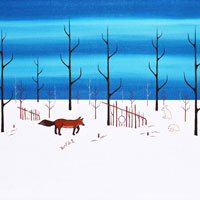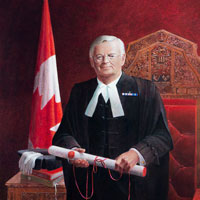Bronze Panels
At the heart of the Senate of Canada’s temporary home, located in the newly renovated and repurposed Union Station (used until recently as the Government Conference Centre), stands a monumental, tripartite mural.
Conceived by the Toronto-based architectural firm Diamond Schmitt, it is composed of over 200 bronze screens that have each been carefully perforated and chemically aged. Seen from a distance, the perforations, of varying sizes and placed at varying distances from one another, form images representing awe-inspiring Canadian landscapes.
The sources of the three images are photographs, two of which are contemporary and a third taken in the late 1950s. The mural situated on the right, as one walks toward the central staircase, is from a photograph of Cape Race, Newfoundland and Labrador, by professional photographer and cinematographer James Lewis, based in St. John’s. Opposite is a view of Moraine Lake, Alberta, by Paul Zizka, an adventure photographer living in Banff. On the wall above, before the staircase, is an image of a train passing over the Kinsol Trestle, British Columbia, by lifelong railway photographer and historian Dave Wilkie.
Through its composition, the three-part mural represents the “bridging” of Canada’s eastern and western regions via the national railway, thereby paying clear tribute not only to the original purpose of Union Station but to the political ideal that formed the basis of Confederation. The vastness of the country is both condensed and evoked by the mural’s structure.
With its perforated metal sheets, the mural also embodies an explicit reference to the halftone printing process, which enabled photography, over the course of the first half of the 20th century, to become an integral part of the mass media. While the photographic image has always been reproducible, the halftone process rendered it eminently printable, and, with the emergence of widely distributed publications like national illustrated magazines, photography became a ubiquitous presence in the lives of Canadians. Combined, the technologies of photography and mass printing made the wide circulation of conventional views of Canada possible.
It is surely no accident that the two images selected to represent the East and the West are iconic – both Cape Race and Moraine Lake are historically important sites that have been photographed and reproduced millions of times (a similar view of Moraine Lake even appeared on the 1969 and 1979 issues of the twenty-dollar bill).
Iconicity is the result of a process through which an image, chiefly through repetition, comes to symbolize an idea – even a whole country – without the addition of explanation or context. In this mural, photographic imagery that had already attained the status of iconicity has been further exalted and monumentalized by its transmutation into bronze, the traditional material of public monuments.
This conversion from one medium to another, from photograph to metal, abstracts from the reality of the landscape pictured and what it may mean to the Canadians who live there. The meaning here does not reside in the lived experience of the land, but in the iconic potency of an image.
Zoe Tousignant is a photography historian and an independent curator based in Montréal, Quebec.
Object details
Title
Bronze Panels
Medium
Photography on bronze panels

Object details: Original photograph
Artist
James Lewis
Title
Cape Race
Medium
Photography
Image copyright
Newfoundland and Labrador Tourism

Object details: Original photograph
Artist
David Wilkie
Title
CNR Extra 2149 West on the Kinsol Trestle Vancouver Island 1858
Date
1958
Medium
Photography
Image copyright
West Coast Railway Association Management

Object details: Original photograph
Artist
Paul Zizka
Canadian
Quebec City, Quebec, 1979
Title
Lake Moraine
Date
2015
Medium
Photography
Image copyright
Paul Zizka



 Teasing The Fox
Teasing The Fox The Honourable Noël A. Kinsella
The Honourable Noël A. Kinsella